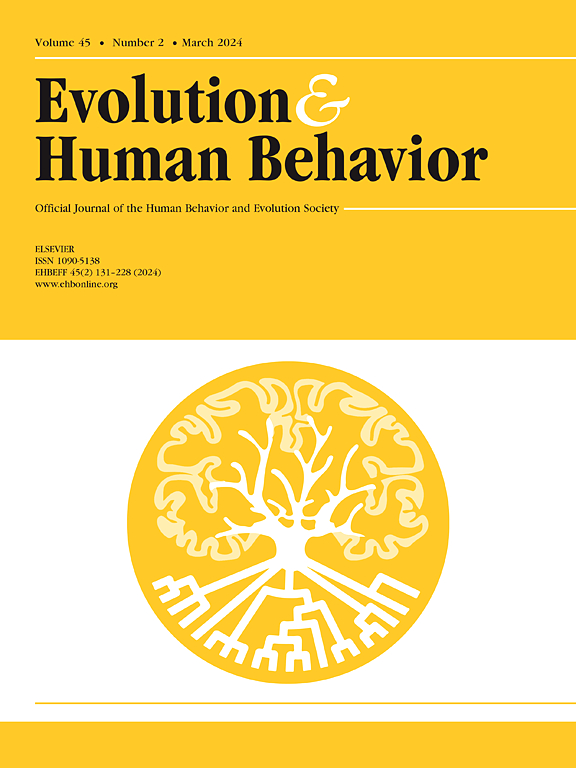孩子们认为独特的相似性是社会伙伴关系中兼容性的更有意义的线索
IF 3.2
1区 心理学
Q1 BEHAVIORAL SCIENCES
引用次数: 0
摘要
鉴于发展和维持社会关系的资源有限,人类可能会优先投资于具有高关联价值的个体,或者那些在相互互动中提供最大净收益的个体。虽然相似性可以指导从属判断,但尚不清楚哪种类型的相似性为有效的社会伙伴关系提供了有意义的基础,从而标志着更高的关联价值。目前的研究旨在调查(1)儿童如何权衡共同的社会类别和共同的偏好作为潜在社会伙伴关系线索的重要性,以及(2)儿童对共同偏好的重视是否取决于它们的稀有性。我们评估了106名日本儿童(4至12岁)对第三方友谊的推断,让他们根据性别和偏好预测角色之间的友谊。孩子们会优先考虑共同的偏好,而不是共同的性别,他们预测一个角色会和一个与他们有共同偏好的异性角色做朋友,而不是和一个没有共同偏好的同性角色做朋友。此外,当共同偏好很少而不是很常见时,这种优先考虑共同偏好的倾向会稍微强一些。当存在多种类型的相似线索时,根据独特的相似性选择社会伴侣可能是适应性的,这表明个人提供了他人不易提供的不可替代的利益。本文章由计算机程序翻译,如有差异,请以英文原文为准。
Children consider unique similarities as more meaningful cues to compatibility in social partnerships
Given finite resources in developing and maintaining social relationships, humans have likely evolved to prioritize investing in individuals with high association value, or those who provide the greatest net benefits in mutual interaction. While it is well established that similarity guides affiliative judgments, it remains unclear which types of similarity provide a meaningful foundation for effective social partnerships and thus signal higher association value. The current study aimed to investigate (1) how children weigh the importance of shared social category and shared preferences as cues to potential social partnerships, and (2) whether the weight that children place on shared preferences depends on their rarity. We assessed third-party friendship inferences in 106 children (ages 4 to 12) in Japan by having them predict friendships between characters based on their gender and preferences. Children privileged shared preferences over shared gender, predicting that a character would be friends with an other-gender character who shared their preference than a same-gender character who did not. Further, this tendency to prioritize shared preferences was slightly stronger when the preferences were rare rather than common. When multiple types of similarity cues are available, it may be adaptive to select social partners based on unique similarities which signal that the individual offers irreplaceable benefits that are not easily supplied by others.
求助全文
通过发布文献求助,成功后即可免费获取论文全文。
去求助
来源期刊

Evolution and Human Behavior
生物-行为科学
CiteScore
8.30
自引率
9.80%
发文量
62
审稿时长
82 days
期刊介绍:
Evolution and Human Behavior is an interdisciplinary journal, presenting research reports and theory in which evolutionary perspectives are brought to bear on the study of human behavior. It is primarily a scientific journal, but submissions from scholars in the humanities are also encouraged. Papers reporting on theoretical and empirical work on other species will be welcome if their relevance to the human animal is apparent.
 求助内容:
求助内容: 应助结果提醒方式:
应助结果提醒方式:


